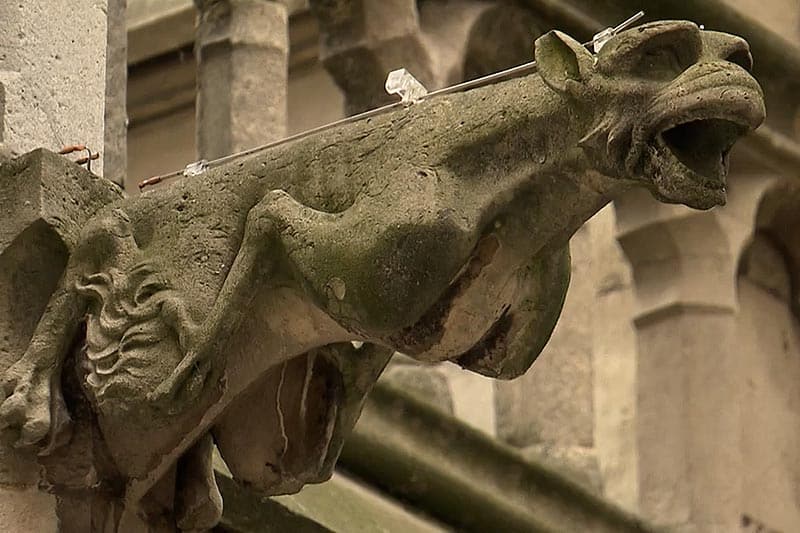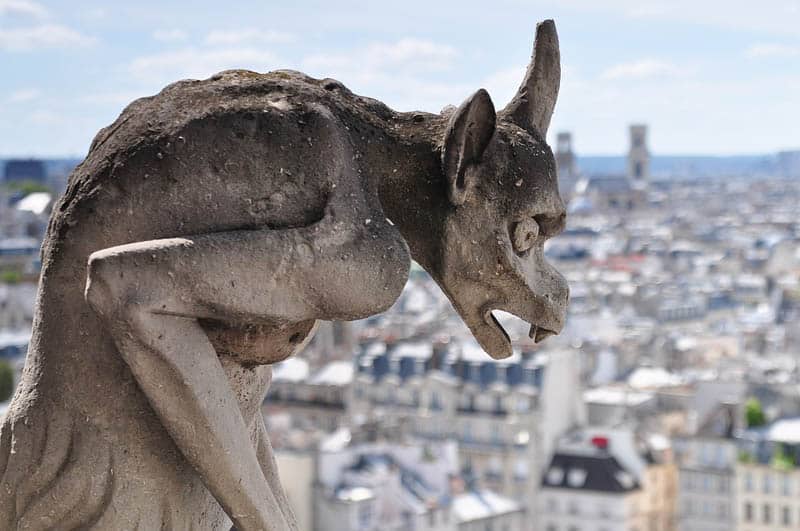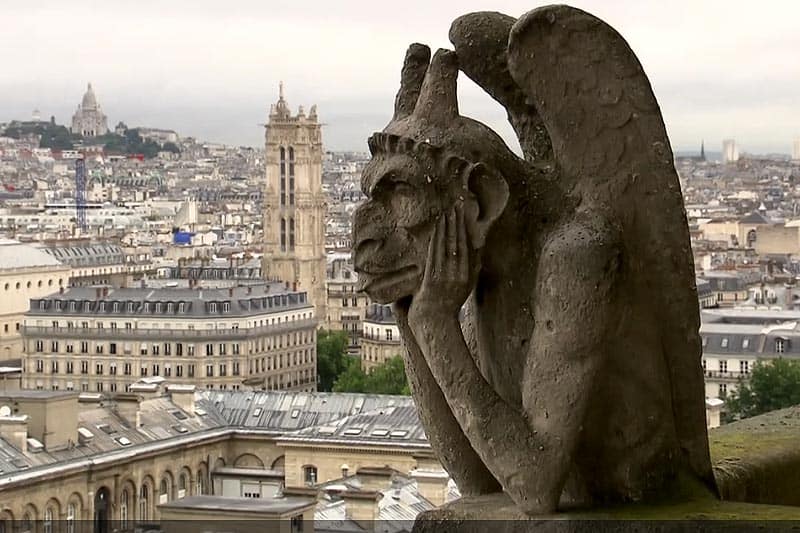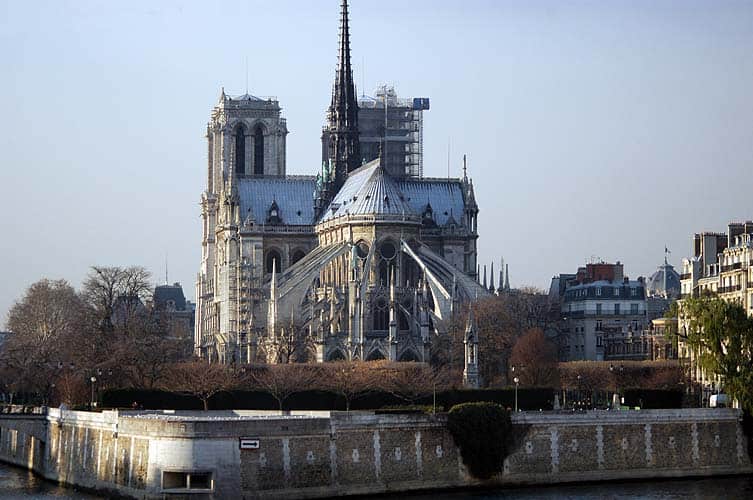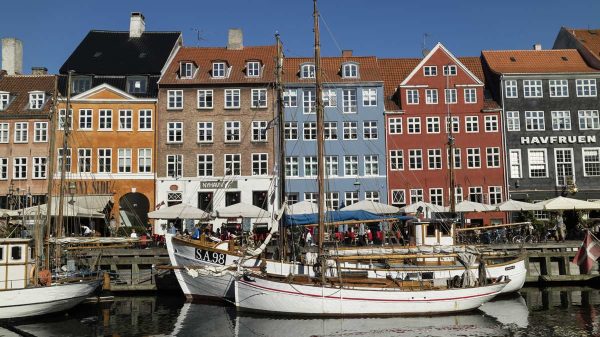En 1163, la première pierre était posée
Combien de temps pour la construire ?
Le 12 octobre 1160, Maurice de Sully est élu évêque de Paris et c’est à lui qu’on doit l’origine du projet « Notre-Dame de Paris ».
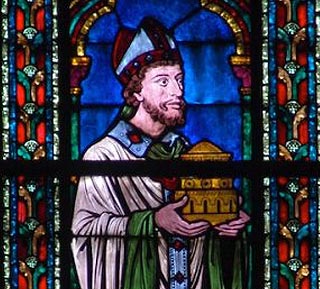
Vitrail de Maurice de Sully à Notre Dame de Paris
Dès son investiture, il parle de restructuration et d’édification. C’est grâce à lui que, trois ans plus tard, la première pierre est posée, en présence du Pape Alexandre III. Nous sommes en 1163.
Dans les 90 années qui suivirent, quatre grandes campagnes de travaux marquèrent cette période, sous la direction de quatre maîtres d’œuvre.
Puis, de la fin du 13e siècle au début du 14e, les travaux sont repris par Jean de Chelles, Pierre de Montreuil, Pierre de Chelles, Jean Ravy, Jean le Bouteiller.
Presque 300 ans après le début de sa construction, Notre-Dame est proche de la version que nous connaissons aujourd’hui. La porte dimensionnelle refléterait donc notre histoire datant de 750 ans en arrière ? Et bien non, car elle sera à nouveau réaménagée au cours des 16e et 19e siècles.
Nous assistons à la construction d’un édifice qui se sera étalée sur 8 siècles. C’est un des points essentiels qui donne à Notre-Dame de Paris ce côté magique et intemporel.
Et je pense que c’est précisément là une des raisons fondamentales de son succès : 13,5 millions de pèlerins et visiteurs par an. Le monument en France et peut-être d’Europe le plus visité. Cela signifie une moyenne de plus de 30 000 personnes par jour, soit un nouveau visiteur toutes les 3 secondes.
Des chiffres fantastiques
- ◼️ 21 hectares de chêne ont été nécessaires pour bâtir la charpente du monument
- ◼️ 1320 plaques de plomb pesant 210 000 kilos servent de toiture à l’édifice
- ◼️ La voûte s’élève à 33 mètres de haut, les tours à 69 mètres et enfin la flèche à 90 mètres
- ◼️ La cathédrale mesure 127 mètres de long
- ◼️ 113 fenêtres percent ses murs
- ◼️ Elle est constituée de 75 colonnes et piliers
- ◼️ Sa superficie totale est de 5 500 m² dont 4 800m² en intérieur.
La cathédrale Notre Dame est un des symboles forts de Paris
Comme la ville, elle s’élève le long des rives de la Seine et sa façade ouest se dresse comme une « vaste symphonie de pierre » selon Victor Hugo.
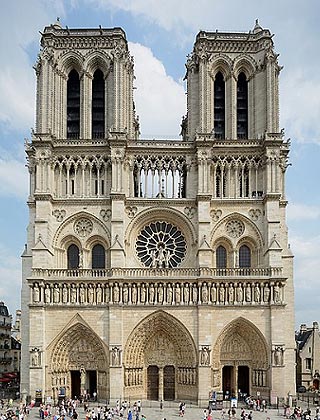
Façade de Notre-Dame de Paris vue du parvis.
Récemment ravalée, elle se dresse dans toute sa magnificence. L’emplacement même de la cathédrale est riche en histoire.
Elle se dresse sur les vestiges d’un temple gallo-romain dédié à Jupiter, d’une église du IVe siècle et d’une basilique du VIe siècle, dans les fondations de laquelle ont été retrouvées douze pierres ayant servi à la construction du temple romain.
Au XIIe siècle, la basilique était en ruine et l’évêque de Paris, Maurice de Sully, décide de la remplacer par une superbe cathédrale capable de rivaliser avec la basilique Saint-Denis.
Le pape Alexandre III pose, en 1163, la première pierre de ce qui allait devenir l’un des chefs d’œuvre de l’architecture gothique. L’ouvrage avance rapidement grâce aux sommes récoltées par l’évêque auprès du roi, du clergé, de la noblesse et même des pauvres.
Lorsqu’elle est achevée, la cathédrale supplante tous les autres monuments religieux élevés en l’Île-de-France.
La restauration
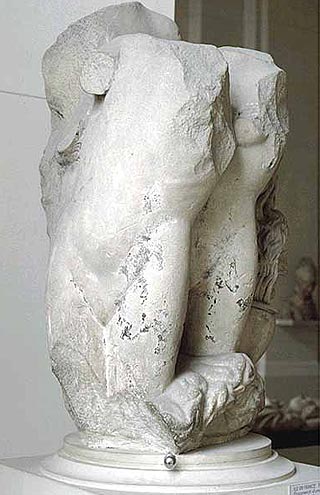
Fragment d’une Descente aux limbes © Musée du Louvre/P. Philibert
L’apparence actuelle de Notre Dame en grande partie due au travail de restauration effectué au XIXe siècle. Aux XVII et XVIIIe siècles, le style gothique est passé de mode et la cathédrale en subit les conséquences.
Sous Louis XIV (1643-1715), le chœur est partiellement détruit, les vitraux du XIIIe siècle sont remplacés par des vitres transparentes, dont les bords sont peints en bleu et or, puis le jubé et les tombes disparaissent (un fragment du jubé « La Descente aux limbes » se trouve au Louvre)
Au cours de la Révolution, la cathédrale est pillée et transformée en temple de la Raison puis de l’être suprême. Les cloches, sauf le gros bourdon de la tour sud, sont fondues pour en faire des canons, et les 28 statues des rois d’Israël et de Juda qui ornent la façade ouest sont prises par les révolutionnaires pour des statues des rois de France et jetées à bas.
Par miracle, 21 de ces têtes ont été retrouvées et sont maintenant conservées au musée de Cluny, sauf celle du roi David qui se trouve au Museum of Art à New York.
En 1804, la cathédrale est dans un tel état de délabrement que, lors du couronnement de Napoléon Ier de grands tapis et tapisseries sont placés dans toute la cathédrale pour dissimuler les dommages.
Comme Victor Hugo l’écrit dans Notre-Dame de Paris, en 1831: « Sur la face de cette vieille reine de nos cathédrales, à côté d’une ride on trouve toujours une cicatrice. Tempus edax, homo edacior. Ce que je traduirais volontiers ainsi : le temps est aveugle, l’homme est stupide. » La publication du roman de Victor Hugo a encouragé les efforts pour sauver la cathédrale et réunir les fonds pour sa restauration. Venez visiter nos Paris hotel.
De 1845 à 1864, l’architecte Eugène Viollet-le-Duc restaure la cathédrale en la dénaturant. C’est ainsi que les culées des arcs-boutants de la nef sont surmontées d’offensants édicules, que la façade sud du transept est chargée d’éléments nouveaux et désastreux et qu’une flèche haute de 90 m est dressée.
Gargouilles et Chimères
Pour les voir de près, il faut gravir plus de 300 marches, là haut, partageant leur point de vue, l’un des plus beaux panorama de Paris. Semblant poser depuis des siècles, elles guettent, veillent, observent.
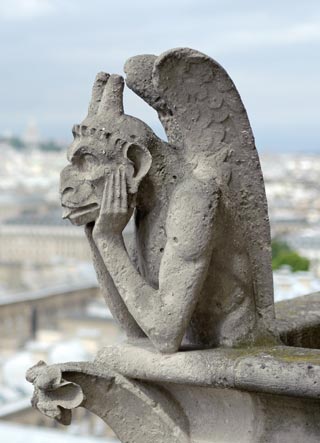
La célèbre Stryge de Notre-Dame.
Les tours de Notre Dame sont habitées par un petit monde fantastique peuplé de créatures légendaires, parfois monstrueuses… gargouilles et chimères, les célèbres sentinelles silencieuses de la cathédrale. Toutes singulières, ces figures animales ou humaines ont une fonction différente.
Les gargouilles, elles, jouent un rôle pratique permettant l’évacuation de la pluie, tout un symbole. L’eau était une force du mal. La force démoniaque de cette eau qui envahit, casse et noie. Il fallait donc les éloigner le plus possible de la cathédrale, d’où cette idée de bras pour sortir l’eau loin des murs et éviter qu’elle détruise les constructions. Une symbolique que l’on retrouve aussi avec les chimères qui sont purement décoratives. Dans lesquelles on lit bien le combat des ténèbres et de la lumière, l’opposition du bien et du mal, le triomphe sur la mort. Ce caractère d’opposition est l’expression du péché et du mal. Gargouilles et chimères, même interprétation du combat contre les assaut du mal. Les gargouilles restaurées existaient déjà au moyen-âge.
Les gargouilles de Notre-Dame sont célèbres. Elles ont été mises en place à l’extrémité des gouttières pour évacuer l’eau de pluie de la toiture et ne désignent que la limite des conduits d’écoulement des eaux. Comme elles dépassent dans le vide, les masses d’eau, parfois impressionnantes, des averses sont rejetées loin des murs de la cathédrale qui ainsi ne s’abîme pas. Qui aurait cru que ces gargouilles n’étaient rien d’autre, à la base, qu’un simple élément utilitaire et décoratif ayant pour but de faire traverser les âges à la Dame de Paris ? Et bien, mission réussie chères Gargouilles !
Les chimères, par contre, statues fantastiques, diaboliques et souvent grotesques, n’ont qu’un objectif décoratif. On les retrouve en haut de l’édifice au sommet de la façade, au niveau de la balustrade qui couronne la galerie supérieure reliant les deux tours et se prolongeant sur leurs quatre faces, la Galerie des chimères. Tous les angles de cette balustrade servent de support ou de perchoir à des démons, des monstres et des oiseaux fantastiques. Ces éléments n’existaient pas au Moyen Âge et sont des ajouts incorporés au 19e siècle. Ces petites touches ajoutées au cours du temps ont contribué à donner cet aspect intemporel à la plus grande des Dames de Paris.
Les chimères, quant à elles, sont un pur produit de la restauration du 19è siècle. Signature, l’architecte : Eugène Viollet-le-Duc. Tout pétrit de cet esprit médiéval, il s’inspire du moyen-âge, mais on peut dire que ce sont des oeuvres issues de sa créativité et, en cela, on le voit qu’il n’a pas été un simple restaurateur. La plus célèbres des chimères et la Stryge, monstre fabuleux qui ne se lasse pas d’examiner la capitale.
D’emblée, elle a impressionné l’imaginaire collectif. La République les a tout de suite adopté et elles sont constitutives de Notre-Dame de Paris, bien qu’elles n’étaient pas présente à l’époque médiévale.
Les sculptures
Les sculptures de la clôture du chœur, œuvre de Jean Ravy, ont servi de sources d’inspiration aux ivoiriers, aux miniaturistes et aux peintres. De part et d’autre du maître autel, on a conservé une Pietà et une statue de Louis XIII par Coustou ainsi que celle de Louis XIV par Antoine Coysevox.
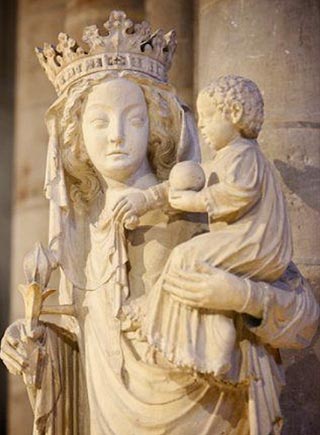
Vierge à l’Enfant du XIVème siècle dite “Notre Dame de Paris” © Godong
La très belle madone du XIVe siècle, dite Notre-Dame de Paris, s’appuie au pilier sud-est du transept. Le trésor de la cathédrale comprend la Couronne d’épines, un Clou sacré et un fragment de la Vraie Croix.
Ces reliques ne sont exposées qu’une fois par an lors de la semaine sainte. Il renferme également d’autres reliques, notamment la tunique de saint Louis, un fragment de sa mâchoire et une côte.
L’orgue du début du XVIIIe siècle, situé sur le mur ouest, a été restauré en 1868 et de nouveau en 1992. Il compte 6000 tuyaux, 110 registres et 5 daviers: c’est le plus grand orgue de France. La vue sur la flèche, les arcs-boutants et la ville est tout à fait remarquable depuis le sommet de la tour sud.
La crypte archéologique
Avant de partir, n’oubliez pas de visiter la crypte pour vous faire un idée juste des fortifications gallo romaines sous le parvis. À gauche, se trouvent les ruines des salles qui utilisaient un système de chauffage appelé hypocauste.
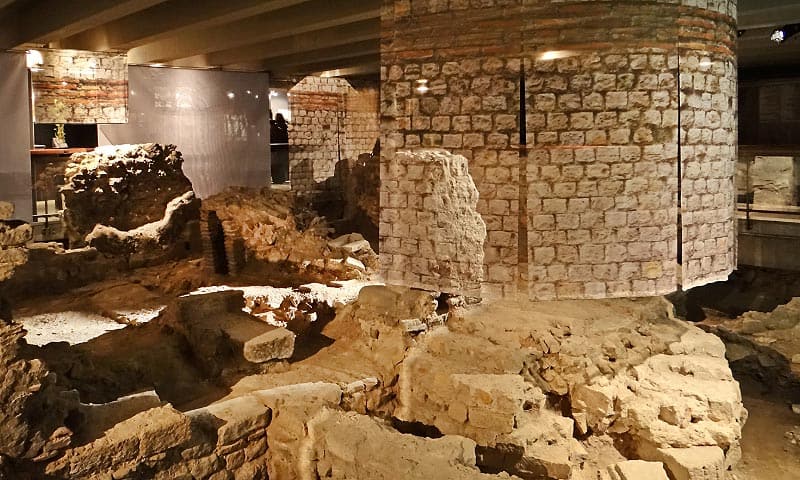
L’incendie de Notre-Dame de Paris en 2019

Incendie de Notre-Dame de Paris. Une du journal le Parisien, le 16 avril 2019.
Triste actualité en ces jours du 15 et 16 avril 2019. Pendant près de 15 heures, un incendie d’une rare ampleur détruira intégralement la flèche, du transept et les toitures de la nef.
Heureusement, la forte mobilisation des pompiers permet de sauver des flammes la structure générale de l’édifice parisien.
C’est le plus important sinistre que la cathédrale ait subi depuis sa construction.
La France est sous le choc. Le monde à les yeux rivés sur la capitale. Le Président de la République, Emmanuel Macron déclare qu’une reconstruction à l’identique de la flèche aura lieu dans les 5 ans à venir.
Conclusion avec les mots d’un parisien
Notre Dame de Paris… Comment conclure en quelques lignes quand on parle de l’une des œuvres les plus marquantes de l’histoire de l’humanité. Par où commencer ? Je pense que ces petits mots qui lui sont adressés feront l’affaire et lui rendront l’hommage qui lui revient de droit.
Vous êtes majestueuse, la plus grande des plus grandes. Les Dames de la haute société n’ont qu’à bien se tenir car vous ne sombrerez pas.
Depuis près de mille ans, vous surveillez Paris et vous vous assurez que la ville continue de refléter en elle votre magie, votre esthétisme et votre splendeur. C’est chose faite ma Dame. Paris vous fait honneur et vous admire en implorant votre grâce.
Pour ma part, vous incarnez notre religion, notre art, notre savoir-faire, notre histoire, notre grandeur et notre futur. Je suis parisien et vous remercie. Je m’endormirai ce soir en sachant que vous continuerez toujours à veiller sur moi.
